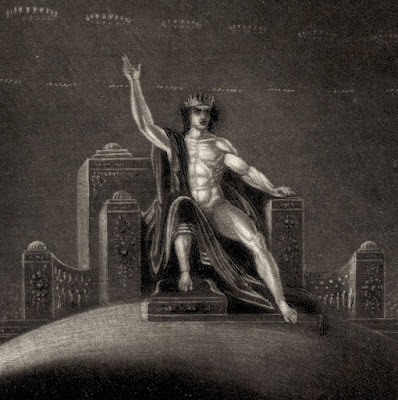John
Martin (1789–1854)
“Satan Presiding at the Infernal Council” (aka “Satan on His
Throne”), 1824, from the series of 24 illustration (in large and small plate formats)
to John Milton's “Paradise Lost”,
first published in 1824/5 by Septimus
Prowett. This impression is from the 1850 edition published by Henry Washbourne.
Mezzotint with drypoint on wove paper trimmed on or within the
platemark (as published) with margins around the image borderline and retaining
the glue edge of the original binding (see lower edge)
Size: (sheet) 18.5 x 27.2 cm; (image borderline) 14.5 x 20.7 cm
Inscribed on plate within the image borderline at the lower edge
right-of-centre: “J. Martin 182[4?]”
Lettered below the image borderline: (centre) "[Designed?]
& Engraved by J.Martin Esqr / Book 2 line 1."
CW 30 (Campbell, Michael J. & J. Dustin Wees 1896,
"Darkness Visible. The Prints of John Martin", Sterling &
Francine Clark Art Institute, Williamstown, Massachusetts)
See also Michael J. Campbell et al 1992, “John Martin, Visionary
Printmaker”, Campbell Fine Art/York City Art Gallery and “The Milton Paradise
Lost Gallery”: http://www.wojm.org.uk/works/milton/milton.htm
Condition: richly inked and well-printed impression retaining the
full margins (as published) and the binding edge with traces of the original
glue still evident (see lower edge). The sheet is in excellent condition (i.e.
there are no tears, holes, folds, abrasions, stains or foxing). The sheet is
backed with archival (millennium quality) washi paper.
I am selling this visually arresting mezzotint by one of the most
famous of the English romantic artists of the 19th century, for the
total cost of AU$183 (currently US$138.10/EUR115.58/GBP101.98) including
postage and handling to anywhere in the world.
If you are interested in purchasing this superb impression, please contact me (oz_jim@printsandprinciples.com) and
I will send you a PayPal invoice to make the payment easy.
This print has been sold
From what I understand, there were l0 editions in total of the
large plates and the small plates, but of the smaller plates—of which this is
one—there were six editions: Septimus Prowett’s edition in 12 parts between
1824 and 1827; Charles Tilt’s edition in 1838; and Henry Washbourne’s five editions
(viz. 1849, 1850 [the edition of this impression], 1853 and 1859).
What I have difficulty in reconciling is how the delicate
surface of a mezzotint could sustain so many editions without obvious signs of
wear to the plate. After all, to my eyes this impression is beautifully crisp
in the retention of the drypoint lines and velvety rich in terms of the large
areas of mezzotint. Admittedly the plates
were subjected to re-working as the British Museum advises: “even as early as
the first re-edition of 1832-3” (see the BM curator’s comment for BM no. 1872,0810.744),
but, even taking into account such intervention, I can see that whatever revisions may have been made, they were not radical and the integrity of the
original artist’s hand remains intact. All that I
can account for the freshness of the present impression is that (again quoting
the curator of the BM [loc cit.]) “Martin worked directly onto the plate, using
Thomas Lupton's new soft steel variety which was more durable than copper.”
Whatever the reason, this impression is marvellously strong and beautiful in
the sensitivity of its superb printing.








No comments:
Post a Comment
Please let me know your thoughts, advice about inaccuracies (including typos) and additional information that you would like to add to any post.